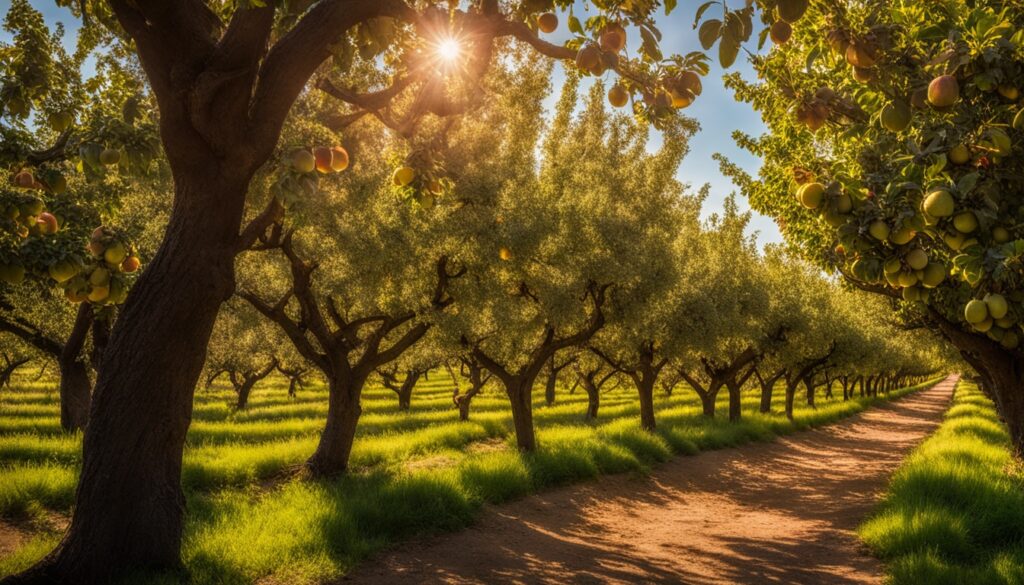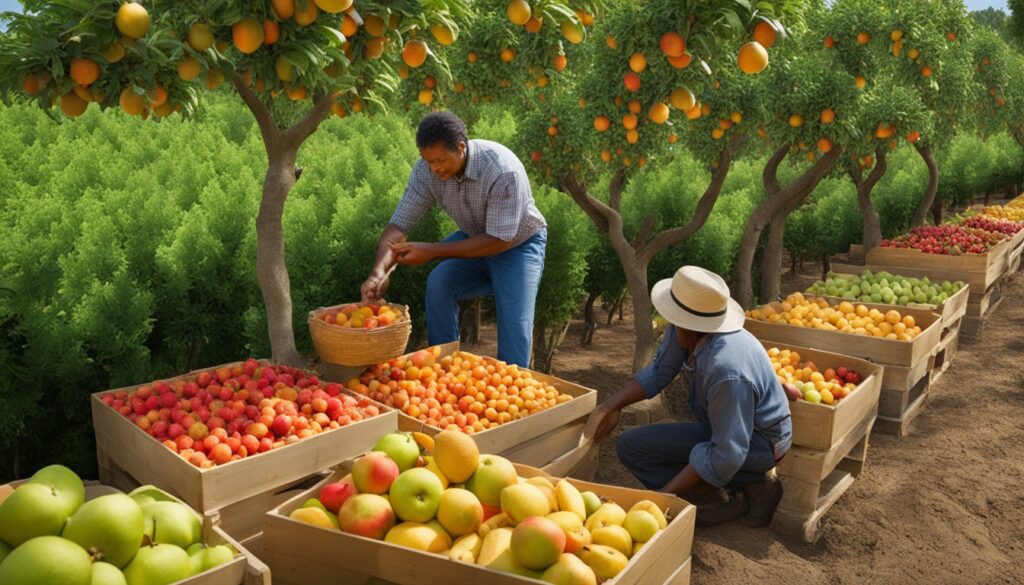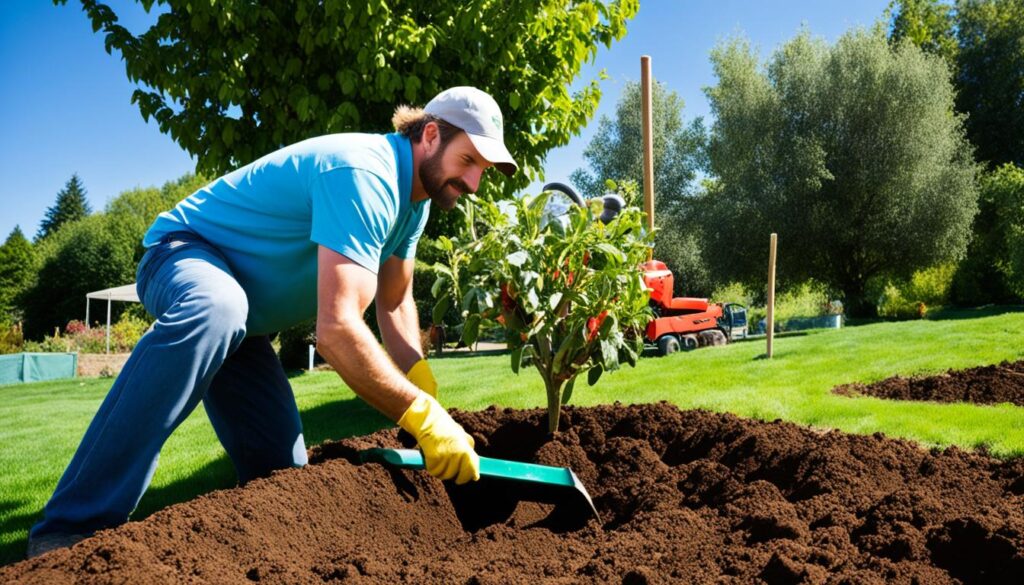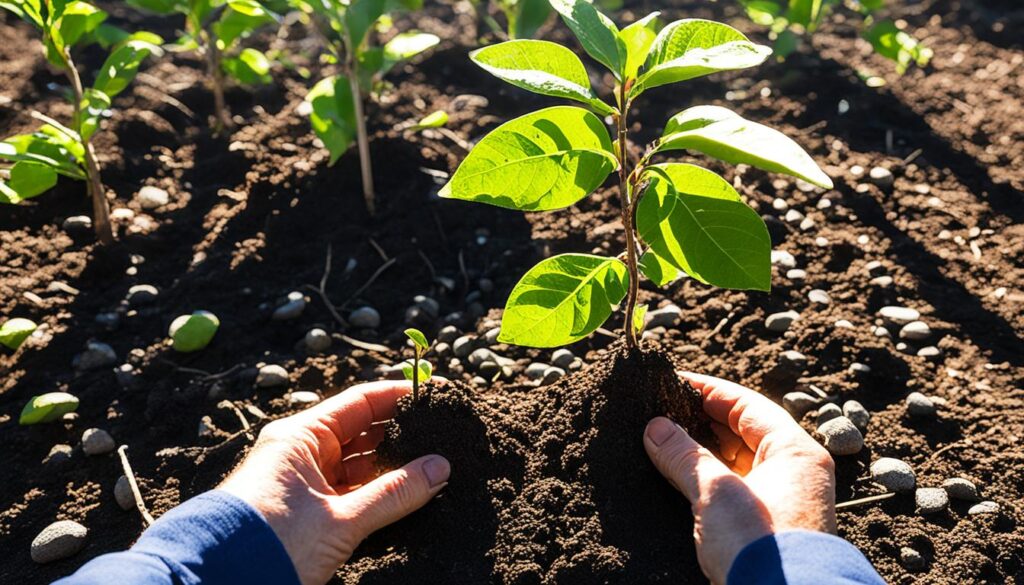Do you dream of a backyard full of juicy, fresh fruit? Growing your own fruit trees is rewarding and sustainable. It gives you delicious fruit every year. But, where do you start? This guide will show you how to plant and care for a fruit tree orchard. You’ll become a pro at planting fruit trees, tree care, and orchard management.
Learn how to pick the best fruit tree varieties for your area. Discover the best pruning techniques, soil preparation, and pest control methods. This article will give you the skills to make a fruitful and green fruit tree orchard. It’s perfect for beginners or experienced gardeners. Get ready to enjoy the fun of fruit tree cultivation and get a big harvest.
Benefits of Growing Fruit Trees
Planting fruit trees at home brings many benefits. It turns your place into a green, self-sustaining spot. These trees give you a steady supply of abundant fruit harvests every year. They don’t need replanting often, making them a great sustainable food source for your family.
Perennial Nature of Fruit Trees
Fruit trees are perennials. They can live for many years and keep giving homegrown produce with little work. You won’t have to replant them often. This means you get to enjoy fresh, healthy fruits from your own orchard easily.
Fresh and Abundant Fruit Harvests
Fruit trees give you lots of fruit, which can save you money. You’ll have a free source of fresh, organic produce. For example, one dwarf apple tree can give over 500 apples a year. This shows how well these trees can produce.
These trees also make your home look better and increase its value. They add beauty, provide shade, and help the environment. They’re a great choice for anyone wanting a lovely, green home.

Choosing the Right Fruit Tree Varieties
When planning your fruit tree orchard, pick varieties that fit your local climate and soil. Use the USDA Plant Hardiness Zone to find trees that do well in your area. Choose disease-resistant types that need little care against pests and diseases. Talking to your local nurseries or extension office can guide you to the best fruit tree types for your garden.
Considering Your Climate and Growing Zone
Each fruit tree type has its own chilling needs. These are the hours it must be cold to bloom and flower well. For example, apple, pear, and peach trees need 200 to 1,700 hours of cold. Picking climate-suitable varieties is key for a good homegrown fruit yield.
Disease-Resistant and Local Varieties
- Find disease-resistant fruit tree types that fight off common pests and diseases in your area.
- Talk to your local nurseries or extension service to find fruit tree types that fit your region and soil.
- Think about picking heirloom or heritage fruit tree types that are more suited to your local weather and soil.

By picking climate-right and disease-resistant fruit tree types, you can have a great orchard. And you’ll get a lot of homegrown fruit for many years.
Selecting Fruit Tree Sizes
Choosing the right size for your fruit trees is key to a successful home orchard. You can pick from compact dwarf and miniature varieties to larger standard trees. Knowing the differences helps you pick the best for your space and how you like to harvest.
Dwarf and Miniature Trees
Dwarf and miniature fruit trees are great for small gardens. They grow to be 8-10 feet tall and wide. This makes them perfect for containers or small city gardens. They’re easy to take care of and still produce lots of fruit.
Semi-Dwarf Trees
Semi-dwarf trees are a good middle choice. They can grow to 12-15 feet tall. These trees give you lots of fruit without taking up too much space. They’re almost twice as productive as dwarf trees.
Standard Trees
Standard fruit trees can get over 25 feet tall. They’re best for big gardens or traditional orchards. They produce a lot of fruit but can be harder to take care of, especially in small spaces.
Think about the space you have, how you like to harvest, and the look you want for your orchard. Picking the right tree size lets you get the most fruit while keeping your garden nice and easy to manage.

| Tree Type | Mature Height | Mature Width | Fruit Yield |
|---|---|---|---|
| Dwarf/Miniature | 8-10 feet | 8-10 feet | Medium |
| Semi-Dwarf | 12-15 feet | 12-15 feet | High |
| Standard | 18-25+ feet | 18-25+ feet | Very High |
planting fruit trees
Starting a fruit tree orchard needs careful planning and attention. Whether you choose bare-root trees or container-grown trees, getting the soil ready and planting right is key. This ensures your fruit trees will do well for a long time.
First, pick a spot that gets at least 8 hours of sunlight a day. It should have soil that drains well and a pH between 6.0 and 7.5. Dig a hole that’s twice as wide and deep as the tree’s roots. Make a mound in the hole to help the roots grow down.
For bare-root trees, spread the roots out in the hole. Fill it with a mix of the local soil and compost, making sure not to plant the tree too deep. Container-grown trees should have their root ball at the same level as the soil. Use a mix of local soil and compost for planting.
| Planting Method | Advantages | Considerations |
|---|---|---|
| Bare-root Trees | More economical, wider variety | Require planting in late winter/early spring |
| Container-grown Trees | Easier to establish, can plant year-round | More expensive, limited varieties |
No matter the tree type, water it well when you plant and during the early growth. Keep the soil moist but not too wet. Mulch around the tree, keeping it at least 3 inches from the trunk to stop rot.

Right planting methods and care are key for your fruit tree orchard’s success. By following these tips, you can help your trees start strong and keep them healthy for many years.
Best Time for Planting Fruit Trees
Planting fruit trees at the right time is key. The best time to plant depends on your local climate considerations. In warm areas, the fall planting season, from October to November, is best.
Warmer Climates: Fall Planting
In warm places, fall planting helps trees grow strong roots before summer heat. This gives them a good start, making them ready to grow well next season.
Colder Climates: Late Winter or Early Spring
In cold areas, plant trees in late winter or early spring, from March to May. This spring planting helps trees get ready before harsh winter comes. It makes sure they will do well over time.
No matter your climate, make sure new fruit trees get enough water when they’re young. Watering them well is key for strong root development and health.

Proper Fruit Tree Planting Techniques
Planting your fruit trees right is key for their health and fruit production. By using the best planting methods, your trees will grow well in your garden.
Hole Preparation
First, dig a hole that’s twice as wide and deep as the tree’s roots. This lets the roots spread out and grow deep. Make the hole shape like a mound at the bottom to help the roots grow down.
Root Spreading and Backfilling
Spread the tree’s roots out so they don’t get tangled. Put the tree in the hole and fill it with a mix of local soil and compost. This gives your tree the nutrients and drainage it needs.
Watering and Mulching
Water the tree well after planting to settle the soil and get rid of air pockets. Keep watering regularly, especially the first year, to help the roots grow strong. Put organic mulch around the tree, but keep it away from the trunk to avoid rot.
By using these planting techniques, hole preparation, root care, backfilling, watering, and mulching tips, you’ll help your fruit trees grow well in your garden.
Pollination Requirements for Fruit Trees
Proper pollination is key for fruit trees to produce lots of fruit. Some fruit trees can pollinate themselves, called self-fertile. Others need cross-pollination with another type of tree. Knowing what your trees need for pollination helps you plan your orchard well.
For example, most peach and tart cherry trees can pollinate themselves. But apples, pears, apricots, sweet cherries, and plums need another tree to help them pollinate. Planting two trees that can pollinate each other within 100 feet works best.
It’s important to match the bloom times of your fruit trees for the best fruit production. Weather, wind, and rain can affect pollination too. So, think about these things when planning your orchard.
| Fruit Tree Variety | Pollination Requirements |
|---|---|
| Apples | Cross-pollination is required for adequate fruit production. |
| Pears | Cross-pollination is required, with some varieties like Seckel and Bartlett not cross-pollinating. |
| Plums | Some varieties are partially self-fertile, but planting two or more varieties ensures consistent fruit production. |
| Sweet Cherries | Mostly require cross-pollination, except for self-fruitful varieties. |
| Peaches and Tart Cherries | Most varieties are self-fertile and can pollinate themselves. |
By knowing what your fruit trees need for pollination and adding the right pollinators, you can have a great orchard. This way, you’ll get lots of fruit every year.
Planning Your Homestead Orchard Layout
Before you plant your fruit trees, plan your orchard’s layout carefully. Start by mapping out your space on paper. Think about sunlight exposure, soil quality, and being close to a water source. This planning makes sure you have enough space for your trees to grow. It also helps with spacing and airflow.
Mapping Your Orchard on Paper
When mapping your orchard, remember to consider shading from buildings or other trees. Also, think about the pollination needs of your fruit trees. A good plan means your orchard will do well over time. It will be more productive and have fewer problems.
Considering Sunlight, Soil, and Water Access
- Look at the sunlight needs of your fruit trees. Make sure they get enough sunlight.
- Check the soil conditions in your orchard area. Fix the soil if needed for the best growing conditions.
- Make sure you can easily get to water for your trees. This could be a nearby water source or a good irrigation system.
Thinking about these important factors early on helps you create a great homestead orchard. It will give you lots of fruit for many years.
Pruning and Training Fruit Trees
Keeping your fruit trees healthy and productive needs careful fruit tree pruning and smart training techniques. Pruning shapes the tree, helps it grow well, and boosts fruit production. Use heading, thinning, and scaffold branch cuts to keep trees balanced and easy to pick.
Training young trees with methods like central leader or modified central leader systems helps their growth. The best crotch angle for fruit trees is 45 to 60 degrees. This makes the tree stronger and more productive. Pruning your trees often keeps them strong and full of fruit.
- Prune all fruit and nut trees when you plant them to balance their tops and roots.
- Prune young trees a little and more when they’re older, especially if they’re not growing much.
- Removing branches makes the tree’s limbs long and flexible. This helps the fruit grow bigger and better.
- Use open center and central-leader training to shape your fruit trees.
- Try espalier training to grow fruit trees flat, saving space and looking nice.
| Pruning Technique | Effect on Tree Growth |
|---|---|
| Thinning Cuts | Slows growth in that area |
| Heading Cuts | Speeds up growth in that area |
| Bench Cuts | Encourages side branches to grow |
Using the right pruning and training techniques shapes your fruit trees for the best productivity and maintenance. This leads to a big and lasting harvest.
Pest and Disease Management
Keeping your fruit trees healthy and productive means fighting pests and diseases early. Use an integrated pest management (IPM) plan to fight pests and diseases. This way, you use fewer harmful chemicals.
Organic Pest Control Methods
Use organic ways to keep your fruit trees healthy. Introduce ladybugs or lacewings to eat pests like aphids and mites. Neem oil or horticultural oils can also kill and keep away many insects.
Good tree care, like giving them enough space and the right water, helps prevent problems. Picking trees that resist diseases and cutting out sick parts also helps fight pests and diseases.
| Organic Control Method | Target Pests |
|---|---|
| Beneficial Predators (Ladybugs, Lacewings) | Aphids, Mites |
| Neem Oil, Horticultural Oils | Wide Range of Insects |
| Proper Cultural Practices (Spacing, Water Management) | Disease Prevention |
| Disease-Resistant Cultivars | Fungal Diseases |
| Removing Affected Plant Parts | Disease and Pest Containment |
Being proactive and sustainable in fighting pests and diseases keeps your fruit trees healthy. This ensures you get lots of fruit for many years.
Harvesting and Preserving Fruit
Once your fruit trees grow and give lots of fruit, you need to know how to harvest and keep it fresh. Picking the fruit at the right time is key. This makes sure it tastes great and feels good to eat. After picking, you can keep your fruit fresh for longer with methods like canning, freezing, or dehydrating.
Deciduous fruits like apples, pears, and quinces do well in many places and are great for orchards. Stone fruits, such as peaches, nectarines, and cherries, are also good choices. Berries, like raspberries, blueberries, and blackberries, are perfect for eating fresh or preserving.
Storing your fruit right lets you enjoy it even after the growing season ends. This way, your orchard work pays off. Learning how to harvest and preserve fruit means you can enjoy your orchard’s fruits all year. You can also share the tasty results with your loved ones.



